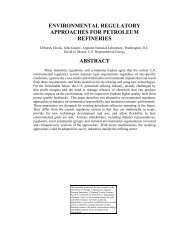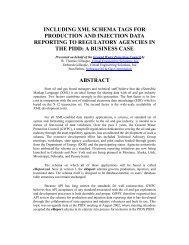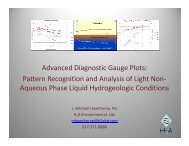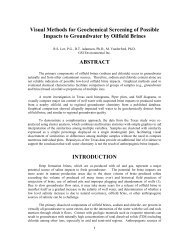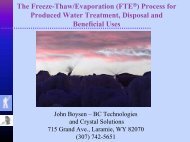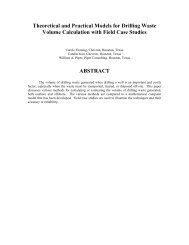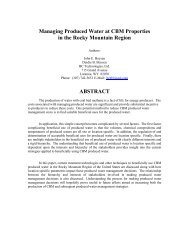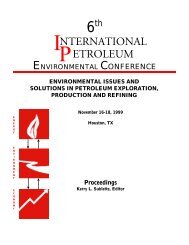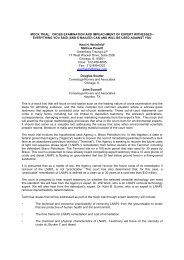Case Studies Identify Induced Gas Flotation as BET - IPEC
Case Studies Identify Induced Gas Flotation as BET - IPEC
Case Studies Identify Induced Gas Flotation as BET - IPEC
Create successful ePaper yourself
Turn your PDF publications into a flip-book with our unique Google optimized e-Paper software.
Application of <strong>Flotation</strong><br />
In<br />
Produced & W<strong>as</strong>te Water Treatment<br />
<strong>IPEC</strong><br />
Houston 2007<br />
Shaya Movafaghian
OUTLINE:<br />
• Introduction<br />
• Evolution of <strong>Flotation</strong> Separation<br />
• Available <strong>Flotation</strong> Techniques<br />
• WEMCO flotation: History and Adaptation to offshore<br />
applications<br />
• WEMCO flotation: Offshore Performance and<br />
Operating Data
Evolution of <strong>G<strong>as</strong></strong> <strong>Flotation</strong><br />
DGF/IGF<br />
WEMCO<br />
•Oil, Petrochemical<br />
•Multiple stage enclosed tanks, vessels<br />
•Sparger, rotor, eductor, revival of<br />
dissolved g<strong>as</strong> pumps<br />
DAF/IAF/<strong>Flotation</strong><br />
Filters<br />
WEMCO<br />
•Paper, Mining, Food<br />
•Single/Multiple stage Tanks<br />
•Sparger, rotor, eductor<br />
DAF<br />
•Municipal, Potable, Sewage<br />
•Large open b<strong>as</strong>ins, ponds<br />
•Dissolved air pumps<br />
1900s<br />
1930s<br />
1960s<br />
1970s<br />
Today
Available <strong>Flotation</strong> Techniques<br />
Compressed<br />
Air<br />
Skim<br />
Compressed <strong>G<strong>as</strong></strong><br />
Source<br />
Influent<br />
Sludge<br />
Effluent<br />
Saturation-<br />
Retention Tank<br />
From<br />
Process or<br />
other source<br />
To Process Tank
Available <strong>Flotation</strong> Techniques<br />
• Dissolved Air/<strong>G<strong>as</strong></strong> floatation<br />
– Oldest technique<br />
– Lowest bubble size distribution (microbubble)<br />
– Developed for large residence time, zero-velocity process.<br />
– Full flow saturation, Split flow saturation, Partial Recycle<br />
– Typically single stage tank for Fisheries/Fruit/Food/Textile with slow<br />
settling floc.<br />
– Resurrected for oil field recently with 25-50% recycle @ 40-70 psig and<br />
BACKGROUND:<br />
WEMCO and Floatation<br />
• WEMCO h<strong>as</strong> been a leading supplier of g<strong>as</strong> floatation machines<br />
for mineral recovery since 1930s.<br />
• In mid 1960s WEMCO introduced the concept for self-induced<br />
g<strong>as</strong> floatation with first WEMCO (1+1) Depurator.<br />
• In 1969 first g<strong>as</strong> induced technique w<strong>as</strong> adopted for secondary<br />
treatment of produced and w<strong>as</strong>te water in petroleum industry in<br />
collaboration with Gulf Oil Co. (ChevronTexaco).<br />
• Today WEMCO Depurator h<strong>as</strong> become an integral part of any<br />
oil-water/w<strong>as</strong>te-water treatment benchmarking process.
BACKGROUND:<br />
Conventional Depurator
BACKGROUND:<br />
Conventional Depurator
THEORY:<br />
Kinetic Approach (Macro Scale)<br />
• Floatation Kinetic Analysis (FKA) for oil field applications:<br />
The most widely accepted kinetic model for IGF implies:<br />
1. Rate of removal is a pseudo-first-order equation.<br />
2. Rate of removal is a direct function of residence time.<br />
(Churchil et al; Degner et al; Chen et al.)<br />
dC<br />
ln<br />
dt<br />
⎡<br />
⎢<br />
⎣<br />
=<br />
C t<br />
C<br />
0<br />
⎤<br />
⎥<br />
⎦<br />
- KC<br />
= − Kt<br />
………..…...(1)<br />
………..…...(2)<br />
C: Contaminant Concentration<br />
t: Hydraulic residence time<br />
K: Kinetic rate constant (empirically derived)<br />
Co: Initial Concentration @ t = 0<br />
Ct: Concentration @ t
THEORY:<br />
Kinetic Valuation<br />
• Commutative Removal Efficiency:<br />
– Kinetic Model for the “n th ”Cell<br />
⎡ 1<br />
( ) ⎥ ⎤<br />
C.R.E = 100 × ⎢1<br />
−<br />
n<br />
⎣<br />
1 + Kt<br />
⎦<br />
• Determinants of C.R.E:<br />
– Residence time<br />
• Individual cell residence time (t)<br />
• Number of cells (n)<br />
– System Kinetic rate constant (K)<br />
• System chemistry<br />
• <strong>G<strong>as</strong></strong> transfer rate<br />
• Bubble size, population, distribution<br />
• Other (geometric and hydraulic)<br />
Others : Arnold’s m<strong>as</strong>s transfer model (1983)<br />
Cumulative Removal Efficiency [%]<br />
………..…...(3)<br />
100<br />
90<br />
80<br />
70<br />
60<br />
50<br />
40<br />
30<br />
20<br />
10<br />
n= 4<br />
n-CELL KINETIC ANALYSIS<br />
(kinetic rate cte.= 1.2)<br />
n= 3<br />
n= 2<br />
n= 1<br />
0<br />
0.00 0.50 1.00 1.50 2.00<br />
Cell Residence Time [min.]
CONVENTIONAL DESIGN:<br />
Kinetic rate verification
CYLINDRICAL DESIGN:<br />
4-Cell (3D)
CYLINDRICAL DESIGN:<br />
Dual-Cell (3D)
CYLINRICAL DESIGN:<br />
Standard Design Subcategories<br />
CYLINDRICAL DEPURATOR<br />
MOTION<br />
FIXED<br />
DUAL CELL<br />
TWO-CELL<br />
FOUR-CELL<br />
n_CELL<br />
5-DC<br />
5-2C<br />
5-4C<br />
Operation Envelope<br />
6-DC<br />
8-DC<br />
6-2C<br />
8-2C<br />
6-4C<br />
8-4C<br />
200000<br />
180000<br />
160000<br />
10-DC<br />
12-DC<br />
10-2C<br />
12-2C<br />
10-4C<br />
12-4C<br />
Rated Cap. [bwpd]<br />
140000<br />
120000<br />
100000<br />
80000<br />
60000<br />
40000<br />
20000<br />
0<br />
12-4C<br />
10-4CX<br />
10-4C<br />
12-2C/DC<br />
8-4C<br />
10-2C/DC<br />
6-4C<br />
8-2C/DC<br />
5-4C<br />
6-2C/DC<br />
5-2C/DC
Performance and Operation Data<br />
• Platform GS Mike Cabinda, Angola (2002-03)<br />
Division of Cooper Cameron Corp.
Gathering Station Mike<br />
Greater Tackula Area, Angola<br />
Courtesy of ChevronTexaco 2002 Supplement to the Annual Report
GS Mike, Cabinda Angola<br />
Pilot Cylindrical Depurator 13 MBWPD
GS Mike Test Results (July-August 2002)<br />
Process Parameters
GS Mike Test Results (July-August 2002)<br />
Four-Cell: Inlet Conditions<br />
Four-Cell Cylindrical Depurator Prototype<br />
Cabinda Angola Platform Gathering Station Mike<br />
20,000<br />
18,000<br />
16,000<br />
Flow<br />
Inlet Contaminant<br />
Outlet Contaminant<br />
250<br />
200<br />
Flowrate [bwpd]<br />
14,000<br />
12,000<br />
10,000<br />
8,000<br />
6,000<br />
150<br />
100<br />
Contaminant [ppm]<br />
4,000<br />
50<br />
2,000<br />
0<br />
0<br />
0 20 40 60 80 100<br />
Test No.
GS Mike Test Results (July-August 2002)<br />
Four-Cell: Efficiency<br />
Four-Cell Cylindrical Depurator Prototype<br />
Cabinda Angola Platform Gathering Station Mike<br />
Removal Efficiency [%]<br />
100<br />
90<br />
80<br />
70<br />
60<br />
50<br />
40<br />
30<br />
20<br />
10<br />
0<br />
Removal Efficiency<br />
0.4<br />
Predicted Removal Efficiency<br />
Residence Time<br />
0.2<br />
0.0<br />
0 20 40 60 80 100<br />
Test No.<br />
2.0<br />
1.8<br />
1.6<br />
1.4<br />
1.2<br />
1.0<br />
0.8<br />
0.6<br />
Residence Time [min.]
GS Mike Test Results (July-August 2002) Four-<br />
Cell: Performance Evaluation<br />
Four-Cell Cylindrical Depurator Prototype<br />
Cabinda Angola Platform Gathering Station Mike<br />
(K= 1.2)<br />
105<br />
100<br />
Removal Efficiency [%]<br />
95<br />
90<br />
85<br />
80<br />
75<br />
70<br />
Removal Efficiency<br />
Four-Cell Cylindrical Depurator Prototype<br />
Cabinda Angola Platform Gathering Station Mike<br />
(K= 1.2)<br />
65<br />
60<br />
Predicted Removal Efficiency<br />
0 20 40 60 80 100<br />
Test No.<br />
Calculated Removal Efficiency [%]<br />
100<br />
98<br />
96<br />
94<br />
92<br />
90<br />
88<br />
86<br />
84<br />
82<br />
5% Error<br />
-5% Error<br />
80<br />
80 82 84 86 88 90 92 94 96 98 100<br />
Actual Removal Efficiency [%]
GS Mike Test Results (July-August 2002)<br />
Four-Cell: Performance Evaluation<br />
Four-Cell Cylindrical Depurator Prototype<br />
Cabinda Angola Platform Gathering Station Mike<br />
(K= 1)<br />
105<br />
100<br />
Removal Efficiency [%]<br />
95<br />
90<br />
85<br />
80<br />
75<br />
70<br />
65<br />
60<br />
Removal Efficiency<br />
Predicted Removal Efficiency<br />
0 20 40 60 80 100<br />
Test No.<br />
Calculated Removal Efficiency [%]<br />
Four-Cell Cylindrical Depurator Prototype<br />
Cabinda Angola Platform Gathering Station Mike<br />
(K= 1)<br />
100<br />
98<br />
96<br />
94<br />
92<br />
90<br />
88<br />
86<br />
84<br />
82<br />
4% Error<br />
-4% Error<br />
80<br />
80 82 84 86 88 90 92 94 96 98 100<br />
Actual Removal Efficiency [% ]
Performance and Operation Data<br />
• Typhoon Production Facility GoM (2004-05)<br />
Division of Cooper Cameron Corp.
Typhoon mini TLP, Green Canyon block 237 A<br />
•Courtesy of ChevronTexaco Annual Report, Dec 2002
Specifications - Typhoon, GoM USA<br />
Name<br />
Typhoon<br />
Location Blocks 236 and 237<br />
Green Canyon area of the Gulf of Mexico<br />
Distance from land<br />
Water depths<br />
100 miles off the co<strong>as</strong>t of Louisiana<br />
2000ft<br />
Equity Chevron (operator) 50%<br />
BHP 50%<br />
Peak production<br />
Field life of<br />
Production<br />
Topsides Structural Deck<br />
Major Process Systems (Oil System)<br />
<strong>G<strong>as</strong></strong> System<br />
Produced Water System<br />
40,000 barrels/day of oil<br />
60 million ft3/day of g<strong>as</strong><br />
Six to eight years<br />
Mini TLP<br />
Two levels consisting of a 110’x110’ Main<br />
Deck and a 110’x110’ Production Deck<br />
(nominal dimensions)<br />
40 MBPD<br />
2 stage separation (2 ph<strong>as</strong>e separation in HP<br />
Separator<br />
3 ph<strong>as</strong>e separation in LP Separator)<br />
60 MMSCFD – 2 stage Main <strong>G<strong>as</strong></strong> Compression<br />
system<br />
5 MMSCFD – 2 stage Vapour recovery<br />
compression system<br />
<strong>G<strong>as</strong></strong> separation in both HP and LP separators<br />
<strong>G<strong>as</strong></strong> dehydration system<br />
15 MBPD Hydrocyclones with downstream<br />
Column <strong>Flotation</strong> Unit<br />
•Courtesy of ChevronTexaco Annual Report, Dec 2002
Model 8-DC Cylindrical Depurator<br />
• Unit overall dimensions: 8’-0” dia. X 19’-0” s/s<br />
• Unit required capacity: 20300 bwpd<br />
• Unit required efficiency: 96.6% suspended O&G
Installation at Typhoon (Jan. 2004)
Installation at Typhoon (Jan. 2004)
Typhoon Process Parameters<br />
Snapshot Dec. 2004
Typhoon Test Results (April-Dec. 2004)<br />
Dual-Cell: Sampling stats<br />
Wemco 8-DC<br />
Typhoon Production Facility<br />
Sample Distribution<br />
0.60<br />
0.50<br />
0.40<br />
Total<br />
Insoluble<br />
Soluble<br />
Frequncy<br />
0.30<br />
0.20<br />
0.10<br />
0.00<br />
0 25 50 75 100 125 150<br />
OIW [ppm]
Typhoon Test Results (April-Dec. 2004)<br />
Dual-Cell: Inlet/Outlet condition<br />
Wemco 8-DC<br />
Typhoon Production Facility<br />
OIW concentration [ppm]<br />
700<br />
600<br />
500<br />
400<br />
300<br />
200<br />
100<br />
0<br />
Samples (4/1/04 to 12/31/04)<br />
Inlet ppm<br />
Soluble Out<br />
Total Out<br />
Inslouble Out
Typhoon Test Results (April-Dec. 2004)<br />
Dual-Cell: Performance vs. predicted eff.<br />
100<br />
Wemco 8-DC<br />
Typhoon Production Facility<br />
Removal Efficiency<br />
Removal Efficiency [ppm]<br />
95<br />
90<br />
85<br />
80<br />
75<br />
Insoluble RE %<br />
96% Efficiency line<br />
70<br />
Apr<br />
Jun<br />
Aug<br />
Sep<br />
Nov<br />
Dec
Typhoon Test Results (March-May 2005)<br />
Dual-Cell: Performance vs. predicted eff.<br />
Wemco 8-DC<br />
Typhoon Production Facility<br />
OIW concentration [ppm]<br />
450<br />
400<br />
350<br />
300<br />
250<br />
200<br />
150<br />
100<br />
50<br />
0<br />
Feb<br />
Mar<br />
Apr<br />
May<br />
Jun<br />
Samples (3/17/05 to 5/30/05)<br />
Inlet ppm<br />
Soluble out
Division of Cooper Cameron Corp.



